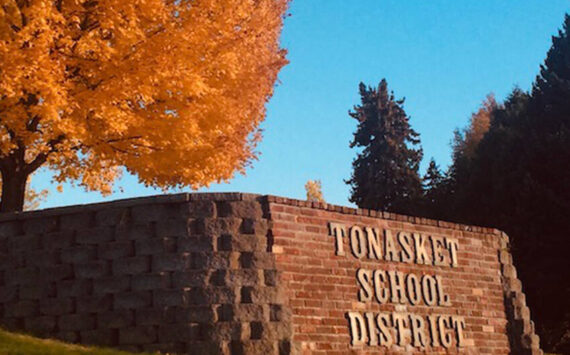Tonasket school board grapples with question
TONASKET – Members of the Tonasket School Board all agreed that community service was something they hoped students embrace and want to involve themselves with.
Whether or not to set community service guidelines as a graduation requirement was another question and led to a lengthy discussion at the board’s Monday, Aug. 26 meeting.
The board did pass a community service policy at the end of the discussion, but with the caveat that it would bring the policy back into play at a future board meeting to gauge the community’s feelings on the matter.
The latter part of the policy, which came directly from the Washington State School Director’s Association, gives the district plenty of leeway in whether or not to implement an actual graduation requirement: “The board will implement an incentive program to recognize students for achievement in community service and may, in its discretion, include community service in the district’s high school graduation/diploma requirements.”
“When we tune into (that), it says ‘and may'” noted Superintendent Paul Turner. “And then it refers to the graduation requirements. That’s all this policy is doing.”
“It’s still discretionary,” said board chairman Jerry Asmussen.
Board member Catherine Stangland said that she felt that such a requirement was part of the school’s responsibility in producing educated citizens.
“As part of being a public school …we are creating citizens,” she said. “For me it’s the idea that kids are understanding that serving their community is an important value.”
“I agree with that part,” Asmussen said. “But you tell a teenager to do anything the odds of them doing it again when they’re 30 is never.”
“I don’t think that’s necessarily true,” Stangland said. “I think for some kids it’s just the opposite.”
“I’m all for encouraging the kids to do community service,” said board member Lloyd Caton. “If you start forcing kids to do community service, it’s something they may not like the taste of and spit it out.”
“You may hear the same argument that kids don’t want to learn,” Stangland said.
Board member Ty Olson said that while he agreed that it was something to be encouraged, doing so was a value that needed to be taught at home first.
“I don’t think we’re in the business of raising kids,” Olson said. “We’re in the business of educating them. Intellectually it’s fun to talk about this, but where the rubber really meets the road… I promise you, when I was 15-years-old and someone made me do something I didn’t want to do… my dad made me change sprinklers and to this day I don’t change sprinklers. It’s the same principle. It may not be the same task or the same job, but when people are made to do things they don’t want to do they seldom do them again.”
School administrators, though not as in sharp disagreement, provided a mix of viewpoints.
High school principal Jeff Hardesty said that no matter what the board decided, it was setting a value statement. He said that with the school’s advisory program, that a vehicle was in place to get the job done if the board decided to move in that direction, but that to be done right it would take time to implement.
“If you say head this direction, I’ll say we can get there in two years,” Hardesty said. “You don’t have to pass a policy saying that this is what’s going to happen (immediately).”
He said there initiatives in place, such as implementing STEM education, the Teacher/Principal Evaluation process and an emphasis on coping with the effects of poverty, that were considered high-priority.
“If you lay out a value statement … then I will figure out how to work it into this very complex thing we call high school, and we’ll get there,” Hardesty said.
Middle school principal Jay Tyus said he felt that community service was an effective way to combat some of the issues associated with poverty among the student population that would be participating in service.
“If we’re going to be servant leaders, we need to teach it,” Tyus said. “That’s not raising someone else’s kid. That’s just an opportunity to say thank you. Look for needs, and solve them. We need to start to find ways around helplessness. One of our major issues in our school, was, we did not see ways around problems… Community service is a vehicle where students become empowered to see solutions to many problems. (Research shows) it’s one of the suggested activities to get rid of helplessness.”
“Community service gives us a vehicle to share opportunities with kids so that they can develop learning experiences,” said special education director Liz Stucker. “They can have exposures that they may not (get at) home.”
Elementary principal Jeremy Clark said his concern was about equal access of opportunities to all students.
“Can we build into our system the supports needed for these kids that are on top of Mt. Hull or whatever, that don’t have gas money?” he asked. “How will they get into town?”
Caton and Asmussen thought that an incentive program, rather than a graduation requirement, might produce a better result.
The board eventually passed the policy unanimously (board member Ernesto Cerillo was absent), acknowledging that as worded it didn’t require an actual requirement to be put in place. The motion included a provision to revisit the issue at the school board’s next meeting.
Addressing effects of poverty
With nearly 70 percent of Tonasket School District students qualifying for free or reduced-price lunch, finding ways to cope with the effects of poverty has become a district priority.
A number of district personnel attended a workshop this summer by Eric Jensen, author of “Teaching with Poverty in Mind: What Being Poor Does to Kids’ Brains and What Schools Can Do about It.”
“For myself it was probably one of the best professional development opportunities I’ve had, not only as an administrator but as a teacher,” Clark said. “It was really the message of hope. That’s something we’ve taken on as a motto for the school this year… empowering students to overcome the stress that they may live in in their daily lives and obstacles they may face.”
Clark said that the challenge will be to let go of preconceived notions about students’ backgrounds.
“It is a monumental task we face as educators,” he said. “We need to be really in tune with the students’ backgrounds, the types of students and families we serve and putting things in their paths to set them up for success.”
Stangland has referenced Jensen’s book at several board meetings, including during the community service discussion. Turner said that Jensen’s research was something that he intends to use to shape the district’s direction this year.
“Wow,” he said of the conference. “The information he threw out there and the takeaways made you really re-think things. It was really good stuff. It fit right along with our ‘problem of practice’ that we addressed the board with (earlier this year regarding) poverty.”
Clark discusses state report card
Clark discussed a letter that he sent to elementary school parents that described the school’s status as an “Emerging Priority” school and action steps that are being taken to improve the school’s standing.
Schools are rated relative to one another in categories that include “Reward,” “Focus,” “Priority,” and an “Emerging” category that adds onto the Focus and Priority designations.
Though the actual definitions of the categories are much more complex (and can be found at http://www.k12.wa.us/esea/publicnotice.aspx), in short the Reward schools are the top 10 percent of schools in reading and math for the past three years (all of the measurements are for three-year averages for Title I eligible schools). The next chunk of schools do not receive any designation. Emerging schools (of which there were more than 150) are those that are not on the Priority or Focus schools (lowest achieving) lists, but are taken from a list of schools deemed to be at risk of falling into either of those categories.
“It was tough to send (the letter) out,” Clark said. “I wanted you (the board members) to be aware that it’s out there so you’re able to address questions from anyone in the community.”
Clark said that he has seen significant improvement already, but that because the scores are based on a three-year average it will be at least another year before Tonasket can be removed from the “Emerging” list.
“We don’t have our new AMO statistics, which is what placed us into the Emerging Priority status,” he said. “The state … went back to 2009-10, and based on the average of those three years. They looked at our Level 1 and Level 2 (the lowest of five levels) students. We had too many in those populations.”
Clark said he was looking forward to the new scores being released.
“By my number crunching, I do believe, at least in the categories for all students in both math and reading, it appears we met our AMO (targets) in the school year. Unfortunately with the three year average we can’t step out of (Emerging Priority) this year, but I have very high hopes and expectations with the staff that by next year we’ll be able to overcome that. Hopefully we’ll soon be seeing the accolades Jeff Hardesty has seen in the high school.”
Staffing
The school board also approved (as part of the consent agenda) the hiring of Stephanie Schertenleib as the head high school girls basketball coach; Jay Aitcheson as seventh grade football coach; Lesa Sevin Smith as part time elementary outreach teacher and certificated substitute Kelsey Smith. They also approved the resignations of special education parapro Ben Blaney and transportation / maintenance custodian Pat Stevens.
Earlier at the July 29 meeting, the board also approved the hiring of middle school teacher Michele Fancher; birth-age 3/grade 1-5 ECE teacher Kari Tommervick; middle school math teacher Carissa Haug; middle school food service clerk Dawn Garton; and nine migrant / bilingual summer school staff.
The Tonasket School Board next meets on Monday, Sept. 9, at 7:30 p.m.




